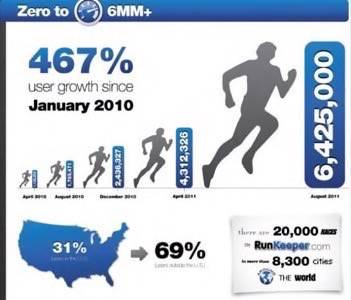Boston-based health and fitness application RunKeeper made big news on Monday with $10 million in funding from a variety of venture capital companies. RunKeeper needs no introduction: it was one of the first health apps in the Apple App Store, has six million users and growing and has a CEO in Jason Jacobs that is full of energy and enthusiasm in building his company and a community of fitness geeks.

Fitness geeks may be the most appropriate term to use when describing RunKeeper and its staff. The startup is fundamentally a data driven company and service. It is also a grassroots community built upon users pushing each other to be healthier, happier people. RunKeeper may be the perfect example of how to build a lean startup through and app, grow it from the ground up and be successful.
Community First, API Next
To have a successful API, you have to have a robust, data-driven community. For those not familiar, RunKeeper is an app that tracks your exercise by distance, heartrate (with a monitor) and other metrics. The company has a variety of other apps in activity tracking and nutrition such as strength and weight tracking apps among others (see the company’s portfolio here).
RunKeeper has never paid a cent for user acquisition. The company firmly believes in the power of community and the viral acquisition of users interested in keeping track of their exercise routines. In that case, the company is almost the opposite of similar products provided by giants like Nike, which pays (and pays well) for brand and loyalty acquisition. RunKeeper did not touch its last round of funding for several months and continued its steep growth trajectory.

The company is built on reporting, data and analytics tied to its social channels and community. This is what made it possible for RunKeeper to create an API it released in June that developers can help grow the ecosystem by building on top of. This is the appropriate way to create and API and one that can lead to tremendous growth (see Facebook). Think of it like a tree. There are many companies that occupy the top levels of a tree, shouting down products, SDKs and APIs on users that may or may not be willing to use them. The API is the trunk that ties the top of the tree to the bottom.
RunKeeper created its data and community by putting roots into the ground and making the foundation very strong. The API is then a step to grow a trunk that can eventually lead to the company occupying the upper level. Developers have been building apps off the API for several months.
“There is a lot of mileage in tapping into the fitness community,” said Sarah Hodges, the director of online marketing at RunKeeper. “The social component does not exhaust itself.”
$10 Million, Now What?
This may sound silly, but the newest round of funding is not going to fundamentally change RunKeeper. It moved to a freemium app earlier this year, it will not begin paid user acquisition and there are no crazy pivots or branches off the tree coming soon. This is the prototypical growth series of funding. More infrastructure, more employees (RunKeeper has 14 openings right now), more office space. It has created all its products, data analysis tools and sales channels in house. There are no gimmicks with RunKeeper.

What is the roadmap? More of the same. It is kind of boring to say but RunKeeper plans on fostering its developer ecoystem through the Health Graph API which in turn helps with brand integration and partnerships into the platform (for instance, Nike could be a brand partner and not a competitor).
“We are going to focus on the core product,” Hodges said. “That means engaging, retaining and acquiring users and letting developers build for us.”
Engage, retain, acquire. It is the ABCs of app building. With its community and API (and now a cushion of cash to give it security), RunKeeper is doing it the right way.





















